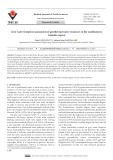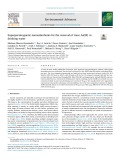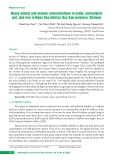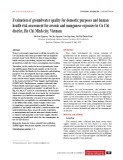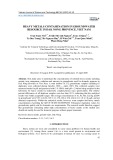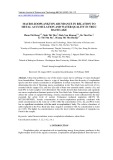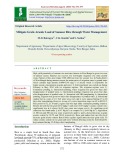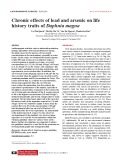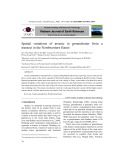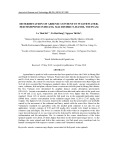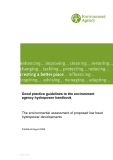
Arsenic concentrations in water
-
The present study investigates the total arsenic (As) content in the samples of drinking water in the Republic of Macedonia, which is obtained from different water sources, such as: springs, surface accumulations, underground accumulations and drilled wells.
 10p
10p  viisac
viisac
 23-09-2023
23-09-2023
 6
6
 1
1
 Download
Download
-
In this paper "Effects of Mn, Cu doping concentration to the properties of magnetic nanoparticles and arsenic adsorption capacity in wastewater" present the studying results of the synthesize process, the magnetic properties, microstructure, surface properties of Mn, Cu doped Fe3O4 nanomaterials and the influence of Mn, Cu concentrations on the arsenic adsorption process in water at different pH.
 7p
7p  runordie3
runordie3
 27-06-2022
27-06-2022
 6
6
 2
2
 Download
Download
-
This paper aimed to determine the grey water footprint (GWF) of geothermal water resources and to investigate the effect of biochar adsorption on grey water footprint in Southeastern Turkey. In this paper, GWF has been calculated in terms of iron (Fe), arsenic (As), manganese (Mn), boron (B), and chrome (Cr) concentrations for fifteen observation geothermal resources located in Southeastern Anatolia Region. In this study, a new approach based on the GWF was developed in order to determine the geothermal water pollution.
 8p
8p  tanmocphong
tanmocphong
 29-01-2022
29-01-2022
 16
16
 2
2
 Download
Download
-
The composite nanomaterials and there parent materials were characterized through pXRD, TEM, FTIR, BET and magnetometry methods (SQUID), and were tested as adsorbents in a representative drinking water matrix containing arsenite (As(III)) at an initial trace concentration (realistic in some natural drinking water sources) of 35 μg/L.
 8p
8p  thebadguys
thebadguys
 15-01-2022
15-01-2022
 11
11
 0
0
 Download
Download
-
This study, tAs is the only element that needs to be further investigated from the relatively high concentration in agricultural soil samples. There were seven out of eight rice samples which had the As level exceeded the Codex standard for polished rice, the inorganic Arsenic (iAs) is also needed to be analyzed for further conclusion.
 13p
13p  nguaconbaynhay10
nguaconbaynhay10
 18-01-2021
18-01-2021
 15
15
 2
2
 Download
Download
-
This study investigated the current situation of groundwater use for domestic purposes and consumption. The research team collected data from several centralized water supply stations operated by the CERWASS. The team also conducted surveys and took water samples from 94 households and water supply stations. The evaluation of groundwater quality and its suitability for domestic use was also conducted. The results showed that in terms of raw water quality, most of the samples had low iron (Fe) concentration and pH value.
 7p
7p  kethamoi7
kethamoi7
 15-08-2020
15-08-2020
 27
27
 3
3
 Download
Download
-
This study aims to understand the concentrations of selected heavy metals including arsenic, iron, manganese, cadmium and mercury in groundwater used for domestic purposes in Dak Nong Province of Viet Nam. A total number of 572 groundwater samples including 61 duplicates were collected during October, 2018 – April, 2019. The collected samples were measured onsite for pH and preserved with 2 % HNO3 until pH < 2 before being analyzed in the laboratory for heavy metals by inductively coupled plasma mass spectrometry.
 8p
8p  angicungduoc5
angicungduoc5
 13-06-2020
13-06-2020
 9
9
 0
0
 Download
Download
-
Urban lake pollution is one of the serious issues due to suffering of waste discharged from householders. However, there is a gap of knowledge about the diversity of zooplankton species and how metals accumulate in zooplankton in urban ecosystems. We addressed this by determining the rule of blooming macro-zooplankton in the Truc Bach lake and levels of two essential metals: copper (Cu), and zinc (Zn) and of three non-essential metals: arsenic (As), and lead (Pb) in water samples were determined.
 8p
8p  angicungduoc5
angicungduoc5
 13-06-2020
13-06-2020
 8
8
 0
0
 Download
Download
-
High yield potentiality of summer rice motivates farmers in West Bengal to grow rice even in summer season. Summer rice receives few fold higher irrigation over other aerable crops. Farmers of this area irrigate 1300-1400 mm water for summer rice. In Nadia district of West-Bengal during summer season, the main source of irrigation water is ground water which contains high amount (0.098-0.345 mgL-1 ) of arsenic which is responsible for higher arsenic concentration in grain and straw.
 6p
6p  chauchaungayxua5
chauchaungayxua5
 05-05-2020
05-05-2020
 5
5
 1
1
 Download
Download
-
A low cost column mode device was designed and fabricated for removal of trivalent and pentavalent arsenic from water. The chemically modified chitosan was entrapped in polyurethane matrix and used as a column bed for adsorption for both the forms of arsenic. The chemical modification of chitosan was achieved by pre-treatment with ferrous oxide manganese oxide. The column bed exhibited 75% of As(III) and 72 % of As(V) removal at 1000 ppb concentration.
 10p
10p  chauchaungayxua3
chauchaungayxua3
 07-02-2020
07-02-2020
 17
17
 0
0
 Download
Download
-
Anthropogenic activities such as industrial production, mining, agriculture and transportation are among the main causes for the increase of trace metal concentrations in the environment, especially in water bodies. In this study, we evaluated the chronic impacts of lead (Pb) and arsenic (As) on Daphnia magna, a crucial organism to aquatic ecosystems, at several concentrations (0, 5, 25, 50, 150 and 250 µgl-1 of Pb and 0, 5, 25, 50 µgl-1 of As) for 21 days. The organism’s life history traits, including survivorship, maturation, and reproduction, were recorded daily.
 6p
6p  chauchaungayxua2
chauchaungayxua2
 07-01-2020
07-01-2020
 27
27
 0
0
 Download
Download
-
Adsorption is one of the primary processes for removing arsenic from drinking water. This study focuses on developing inexpensive and effective adsorbents to remove arsenic from ground water. Eight different types of adsorbents were prepared. Some of these materials were chemically modified. The efficiency of percentage adsorption of arsenite, As(+III) on different materials were investigated at different pH, contact time and initial concentrations. Out of eight different types of adsorbents, the iron-loaded xanthated orange waste (Fe-XOW) showed high efficiency for the removal of arsenic.
 10p
10p  nguathienthan1
nguathienthan1
 27-11-2019
27-11-2019
 39
39
 3
3
 Download
Download
-
In this study, the groundwater from a transect in the Northwestern area of Hanoi was examined. The results showed that 28.8% the wells of the B-B’ transect exceed the WHO guideline value for arsenic concentration in drinking water. The arsenic concentrations varied in a wide range from point to point, with the highest concentration found at Van Phuc and the lowest one found at Cam Yen. They also varied accordingly to the depth.
 8p
8p  meolep1
meolep1
 28-11-2018
28-11-2018
 19
19
 1
1
 Download
Download
-
In this study, arsenic concentration in water, sediment, fish and plant collected from a wastewater fed-fish pond in Hoang Mai district, Ha Noi, Vietnam were determined by graphite furnace atomic absorption spectrometry (GF/AAS). Arsenic concentration in water collected from inlet and outlet sites of the pond were of 45.86 and 23.22 µg/L, respectively and those levels were higher than the Vietnamese standard.
 8p
8p  cumeo3000
cumeo3000
 01-08-2018
01-08-2018
 23
23
 0
0
 Download
Download
-
The preconcentration method of mercury and arsenic in the ground water samples by co-precipitation with PbS was developed. In the range of HCl concentrations from 0.1 - 0.6M and 10 mg of Pb as a collector in the sulphite form after adding 2% thioacetamide solution, the traces of mercury and arsenic were quantitatively separated from a large volume water sample (200 ml). This method has been applied for determination of mercury and arsenic traces in the ground water samples collected in Ho Chi Minh City by neutron activation analysis. The method is simple, rapid and reliable.
 5p
5p  uocvong04
uocvong04
 24-09-2015
24-09-2015
 62
62
 6
6
 Download
Download
-
This paper studied the effects of Co, Ni replacement in the Fe1-xCoxFe2O4 and Fe1-yNiyFe2O4 (x, y = 0, 0.05, 0.1, 0.2, 0.5) nanoparticles, pH, weight of nanoparticles/ml of water and time of stirring on the arsenic removal ability. The results showed that small amount of 0.25 g/l of Fe3O4 nanoparticles after stirring time of 3 minutes can reduce the arsenic concentration from 0.1 mg/l to 0.01 mg/l. The removal was also affected by the pH of the water.
 5p
5p  tuanlocmuido
tuanlocmuido
 19-12-2012
19-12-2012
 36
36
 1
1
 Download
Download
-
Nano-dimensional MnO2 were prepared in ethanol – water media from their inorganic salts by parallel redox reactions. The pH of solution, concentration of the salts and ethanol as well as reaction temperature were the key parameters for forming of nano-particles and anticoagulation. The MnO2 particles in colloidal solution then were coated on calcinated laterite grains to create new adsorption materials.
 6p
6p  tuanlocmuido
tuanlocmuido
 13-12-2012
13-12-2012
 54
54
 6
6
 Download
Download
-
Mercury concentrations have shown a maximum of eight parts per trillion prior to entering Lake Athabasca. The Alberta guideline, which is the most protective of any in North America, is 13 parts per trillion. To put it in perspective, one part per trillion is equivalent to one drop of detergent in enough water to fill a string of railroad tank cars 16 kilometers (10 miles) long. For arsenic, all of the samples collected since 1990 have been below provincial water guidelines. The province has been actively sampling traditional foods in the area (e.g.
 45p
45p  yeurauxanh88
yeurauxanh88
 28-09-2012
28-09-2012
 44
44
 2
2
 Download
Download
CHỦ ĐỀ BẠN MUỐN TÌM











